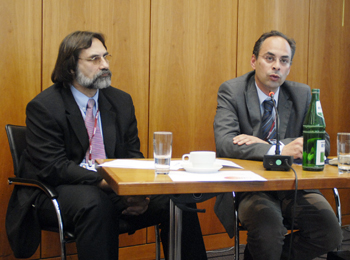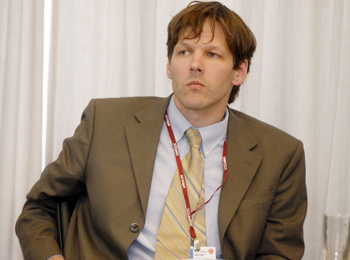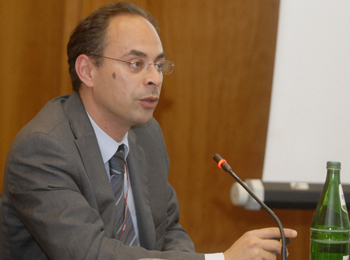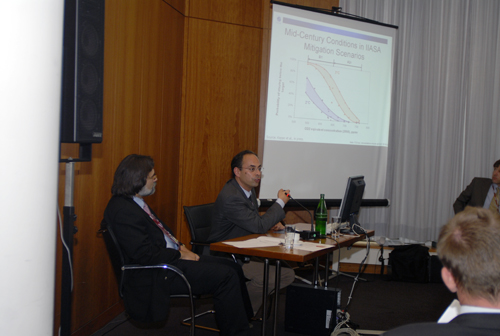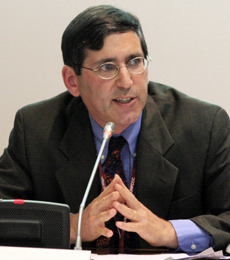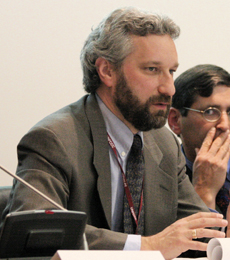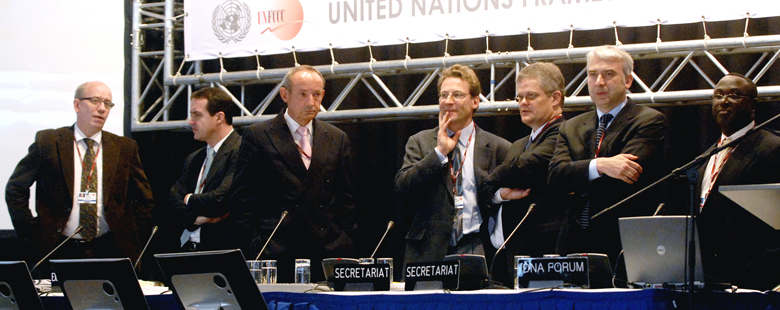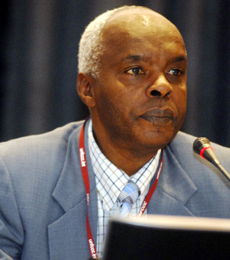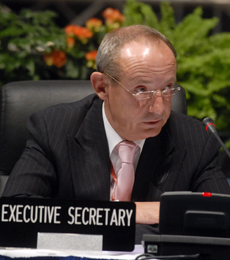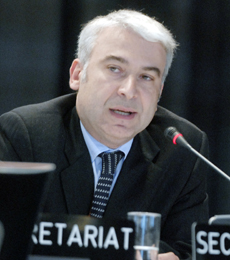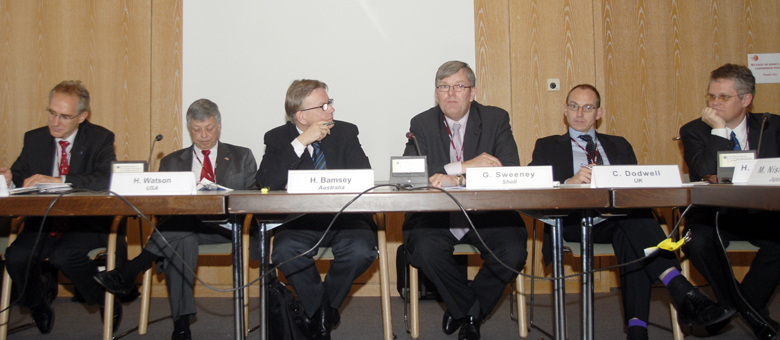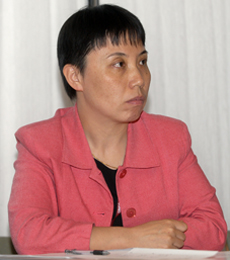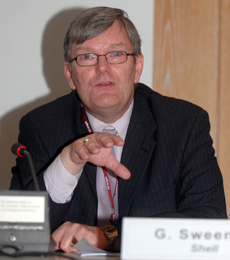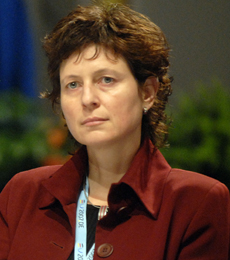 |
||
|
Published by the International Institute for Sustainable Development (IISD)
|
|||
|
A Special Report on Selected Side Events at the twenty-sixth sessions of the Subsidiary Bodies (SB 26) of the United Nations Framework Convention on Climate Change (UNFCCC)
|
|||||
| 7-18 May 2007 | Bonn, Germany | |||||
 |
|||
 |
|||
Events convened on Monday, 14 May 2007
|
Keeping options open through mid-century targets Presented by the International Institute for Applied Systems Analysis |
|||
|
Brian O’Neill, International Institute for Applied Systems Analysis (IIASA), discussed mid-century targets as indicators that link long-term goals to short-term actions, focusing on concentration targets. He said interim targets can retain a range of long-term options and overcome, e.g., the uncertainty and political disagreement delaying long-term goal adoption, and lack of policy certainty implied by short-term targets.
Keywan Riahi, IIASA, underscoring the goal of identifying robust mid-century conditions, said about an 80% increase in the share of carbon-neutral energy shares is needed by 2050 to achieve a long-term goal of a 2 degree Celsius increase in temperature. Riahi emphasized the need for investment in the energy sector in the short-term due to the long lifetime of the needed capital. Michael Obersteiner, IIASA, discussed the land-use dimension, and highlighted that mid-century targets are crucial in integrating land-use-related policies, as most of the agricultural development will be revealed by 2050. He emphasized the importance of a stable share of bioenergy in the renewable energy portfolio by mid-century in retaining the option of meeting long-term targets. Nebojsa Nakicenovic, IIASA, emphasized the strong coupling between the land-use and energy sectors and the path dependency that becomes apparent when looking at mid-century indicators. Fabian Wagner, IIASA, emphasized that mid-century targets highlight the climate change and air pollution nexus, as a mid-term focus increases the importance of mitigating short-lived gases, and that this linkage can be used to exploit the co-benefits. He presented examples of the co-benefits, showing that, e.g., GHG mitigation with high air-quality standards result in high cost-savings. In the ensuing discussion, participants considered: IIASA scenarios for cumulative energy investments; aerosols’ effect on uncertainty in the models; and new technologies in the energy sector. |
|||
|
|||
|
Building on Pocantico: Sectoral agreements and policy-based commitments in a post-2012 climate framework Presented by the Pew Center on Global Climate Change |
|||
|
Daniel Bodansky, University of Georgia School of Law, discussed international intergovernmental sectoral agreements’ potential contributions to a broader framework. He discussed sectoral approaches’ potential to: leverage agreement among a few parties into a global transformation; broaden participation; highlight complementarities between priorities; simplify negotiations; target sectors where action is most needed or can be made easily; and address competitiveness concerns. He emphasized that some sectors are particularly likely to be good candidates based on, e.g., rate of emissions increase, degree of industry concentration, and industry homogeneity. He discussed design issues including: substantive content; participation; degree of international prescription; and stringency. Bodansky said comparing efforts across sectors and countries, and sectoral commitments’ relationship to other commitment types, were notable challenges.
Harald Winkler, Energy Research Centre, responded, saying that sectoral approaches’ lack of comprehensiveness, the difficulty of negotiating specific sector standards, the potential quantity of separate agreements needed, and the international regulation of multinational corporations (MNCs) were causes for concern. Artur Runge-Metzger, the European Commission, noted that sectoral approaches are not new. Emphasizing the benefits of practicality and of simpler negotiations, and the need for a “critical mass” of participants, he underscored the importance of incentives and of considering sectoral approaches to minimize “leakage.” Joanna Lewis, Pew Center on Global Climate Change, presented on policy-based commitments, whereby countries are not bound to economy-wide limits but employ any of a range of policy instruments aimed at reducing emissions. Noting consideration of policy commitments in the pre-Kyoto debate, she said those envisioned now are, e.g., envisioned solely for developing countries and only one of multiple commitment types. Lewis said targets are not politically feasible post-2012, while policy-based commitments could promote broader agreement and synergies with other priorities. She emphasized that policies’ and measures’ bottom-up nature could evolve and be incorporated into the broader framework. Lewis highlighted the challenge of balancing credibility with flexibility and discussed: options for assessing implementation; measures of progress; emissions crediting and other incentives; and explicit recognition of the priority of development. In response, Runge-Metzger emphasized: potential co-benefits; the difficulty of monitoring and its role in improving policy; the relevance of the IPPC Fourth Assessment Report of Working Group III; and sectoral agreements’ potential complementarity. Winkler underscored that policies and measures can either be commitments or means to meeting commitments, and the possibility of mobilizing development funding for climate policies. Elliot Diringer, Pew Center on Global Climate, emphasized the emergence of stronger political will as the critical issue. |
|||
|
|||
|
Implementing the Nairobi Framework: A mobilization event Presented by the UNFCCC Secretariat |
|||
|
Kivutha Kibwana, Minister of Environment and Natural Resources, Kenya, and COP-12 President, recalled the launching of the Nairobi Framework at COP-12 and highlighted the Framework’s specific target of assisting developing countries, especially in Sub-Saharan Africa, in elaborating and carrying out CDM projects. He said increased cooperation with UN agencies can foster assistance and called on more stakeholders to mobilize and participate in CDM projects. Kibwana stressed the importance of mobilizing funds for delivering energy services in Africa, while providing for basic human needs and generating carbon credits.
Yvo de Boer, UNFCCC Executive Secretary, noted the exponential growth and success of CDM projects, with Africa accessing only 2% of such activities. Stressing that such imbalance is unacceptable, he highlighted the need to catalyze CDM projects in Africa and welcomed UN agencies’ efforts. He informed participants of the CDM bazaar, a comprehensive CDM share tool that will serve as a matchmaker between project developers and partners. Danielle Violetti, UNFCCC Secretariat, underscored the importance of UN agencies working together to foster CDM projects in Africa. He summarized the CER distribution in Africa, which includes Egypt, Tunisia, Uganda, Morocco, Nigeria, and South Africa and welcomed the new partners, Côte d'Ivoire, Kenya, Senegal and Tanzania. Yannick Glemarec, UNDP, described UNDP strategies for CDM projects, which aim to: expand the number of countries accessing the market; increase sectoral coverage; maximize the sustainable development dividend; and build capacity to combine funding sources. He noted UNDP efforts to remove barriers to carbon finance by, e.g., establishing an efficient host-country procedure for CDM, and providing project management services to individual project developers. Glemarec noted Africa’s abundant yet untapped bio-carbon opportunities in agriculture and land use. John Christensen, UNEP, noted that CDM barriers in Africa include: limited access to finance; lack of trained national CDM consultants; limited budgets for operations of Designated National Authorities (DNAs); and low flow of investments. He said UNEP initiatives include: providing operationalization support to DNAs; funding preparation of pipeline projects; promoting capacity building activities; and consulting with stakeholders to facilitate efficient and effective completion of the CDM project cycle. William Agyemang-Bonsu, Co-Chair of the DNA Forum, outlined CDM barriers in Africa, such as: limited institutional capacity; limited awareness of potential CDM projects; inadequate financing options; limited capacity to undertake unilateral projects; and limited capacity of banking institutions to finance viable projects. He summarized some possible solutions, including developing sub-regional projects, and promoting capacity building at various levels of society and across the entire CDM project cycle. Konrad von Ritter, World Bank, said that in response to CDM barriers, the World Bank developed a carbon finance assistance program for Africa with the support of a number of bilateral donors. He noted that the program focuses on overcoming barriers, providing institutional capacity and engaging finance and private sector participation. |
|||
|
|||
|
Policy directions to 2050: The business contribution Presented by the World Business Council for Sustainable Development (WBCSD) |
|||
|
Halldor Thorgeirsson, UNFCCC Secretariat, noted lack of trust among parties, and called for unprecedented efforts by the public and private sectors. He underscored the need for: setting the carbon price; increasing investment in R&D and new technologies; addressing intellectual property right (IPR) issues; and fostering clarity for business investments.
Howard Bamsey, Australia, said the side event aimed to explore the role business and governments can play in shaping the future climate context. He asked participants to provide views on clarity to generate investments, IPR issues and carbon prices. Graeme Sweeney, Shell, disagreed that climate policy is technology neutral, said that policy clarity determines whether or not a project is “bankable,” and noted the need to set a clear carbon price. He highlighted political, technical and commercial risks and how to deal with them. Chris Dodwell, UK, noted there are different types of interventions that can: address political risks related to carbon mechanisms; push forward energy technology through R&D; and identify barriers for technology transfer. Joachim Hein, German Industry Federation, noted room for improvement in Germany regarding clarity and incentive for investments. He stressed the importance of identifying what businesses can do alone and the areas in which government support is needed. Gail Kendall, CLP Group, underscored CLP’s voluntary renewable energy target and noted that the Chinese national renewable energy legislation recognizes the different costs of technologies, which are reflected in the energy prices. Li Lyan, China, said that the Chinese government is providing a framework to encourage investment in a sustainable way and is facing the challenges of trying to achieve the ambitious national energy efficiency target. She highlighted the clear framework that the government set up for CDM projects. Harlan Watson, US, said there is an implicit carbon price in the US economy reflected in fuel prices. He questioned whether cap and trade fosters technological innovation. He highlighted US policies that encourage business investment in new and cleaner coal technologies and R&D, and a number of voluntary programmes to reduce emissions. Russell Mills, Dow Chemical, underscored the need to find ways to involve the private sector in achieving different commitments that lead towards a common goal. He underscored the importance of the “cap and trade” system in promoting economic effectiveness and improvements in the environment. Mutsuyoshi Nishimura, Japan, underscored the need for first discussing what the next framework will be regarding mitigation efforts and, second, to examine the tools that could be used. He said IPRs should be respected. Yoshiharu Tachibana, Tepco, underscored the Tepco voluntary programme built in the Japanese context with close consultation with the government. He noted that innovation is the key driver of economic development and underscored the need for mechanisms that encourage innovation. |
|||
|
|||
|
||
|
Click the above button to go back to our ENB main coverage
|
||
|
|
|
|
|
||
|
